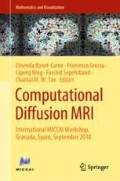Abstract
The estimation of the apparent axon diameter (AAD) via diffusion MRI is affected by the incoherent alignment of single axons around its axon bundle direction, also known as orientational dispersion. The simultaneous estimation of AAD and dispersion is challenging and requires the optimization of many parameters at the same time. We propose to reduce the complexity of the estimation with an multi-stage approach, inspired to alternate convex search, that separates the estimation problem into simpler ones, thus avoiding the estimation of all the relevant model parameters at once. The method is composed of three optimization stages that are iterated, where we separately estimate the volume fractions, diffusivities, dispersion, and mean AAD, using a Cylinder and Zeppelin model. First, we use multi-shell data to estimate the undispersed axon micro-environment’s signal fractions and diffusivities using the spherical mean technique; then, to account for dispersion, we use the obtained micro-environment parameters to estimate a Watson axon orientation distribution; finally, we use data acquired perpendicularly to the axon bundle direction to estimate the mean AAD and updated signal fractions, while fixing the previously estimated diffusivity and dispersion parameters. We use the estimated mean AAD to initiate the following iteration. We show that our approach converges to good estimates while being more efficient than optimizing all model parameters at once. We apply our method to ex-vivo spinal cord data, showing that including dispersion effects results in mean apparent axon diameter estimates that are closer to their measured histological values.
Access this chapter
Tax calculation will be finalised at checkout
Purchases are for personal use only
References
Zhang, H., et al.: Axon diameter mapping in the presence of orientation dispersion with diffusion MRI. NeuroImage 56(3), 1301–1315 (2011)
Jelescu, I.O., et al.: Degeneracy in model parameter estimation for multicompartmental diffusion in neuronal tissue. NMR Biomed. 29(1), 33–47 (2016)
Gorski, J., et al.: Biconvex sets and optimization with biconvex functions: a survey and extensions. Math. Method Oper. Res. 66(3), 373–407 (2007)
Alexander, D.C.: A general framework for experiment design in diffusion MRI and its application in measuring direct tissue-microstructure features. MRM (2008)
Alexander, D.C., et al.: Orientationally invariant indices of axon diameter and density from diffusion MRI. NeuroImage 52(4), 1374–1389 (2010)
Assaf, Y., et al.: AxCaliber: a method for measuring axon diameter distribution from diffusion MRI. MRM, 1347–1354 (2008)
Huang, S.Y., et al.: The impact of gradient strength on in vivo diffusion MRI estimates of axon diameter. NeuroImage 106, 464–472 (2015)
De Santis, S., et al.: Including diffusion time dependence in the extra-axonal space improves in vivo estimates of axonal diameter and density in human white matter. NeuroImage 130, 91–103 (2016)
Daducci, A., et al.: Accelerated microstructure imaging via convex optimization (AMICO) from diffusion MRI data. NeuroImage 105, 32–44 (2015)
Farooq, H., et al.: Microstructure imaging of crossing (MIX) white matter fibers from diffusion MRI. Nature Sci. Rep. 6, 38927 (2016)
Vangelderen, P., et al.: Evaluation of restricted diffusion in cylinders: Phosphocreatine in rabbit leg muscle. J. Magn. Reson. Ser. B 103(3), 255–260 (1994)
Kaden, E., et al.: Parametric spherical deconvolution: inferring anatomical connectivity using diffusion MR imaging. NeuroImage 37(2), 474–488 (2007)
Zhang, H., et al.: NODDI: practical in vivo neurite orientation dispersion and density imaging of the human brain. NeuroImage 61(4), 1000–1016 (2012)
Kaden, E., et al.: Multi-compartment microscopic diffusion imaging. NeuroImage 139, 346–359 (2016)
Fick, R., et al.: Dmipy: an open-source framework to improve reproducibility in Brain Microstructure Imaging. In: HBM (2018). https://github.com/AthenaEPI/dmipy
Fick, R., et al.: Dmipy: an open-source framework for reproducible dMRI-based microstructure research (Version 0.1). Zenodo (2018). https://doi.org/10.5281/zenodo.1188268
Duval, T., et al.: Validation of quantitative MRI metrics using full slice histology with automatic axon segmentation. In: ISMRM, p. 928 (2016)
Cohen-Adad, J., et al.: White matter microscopy database (2017). https://doi.org/10.17605/OSF.IO/YP4QG
Panagiotaki, E., et al.: Compartment models of the diffusion MR signal in brain white matter: a taxonomy and comparison. NeuroImage 59(3), 2241–2254 (2012)
Tanner, J.E., Stejskal, E.O.: Restricted self-diffusion of protons in colloidal systems by the pulsed-gradient, spin-echo method. JCP 49(4), 1768–1777 (1968)
Storn, R., Price, K.: Differential evolution—a simple and efficient heuristic for global optimization over continuous spaces. J. Global Optim. 11, 341–359 (1997)
Burcaw, L.M., et al.: Mesoscopic structure of neuronal tracts from time-dependent diffusion. NeuroImage 114, 18–37 (2015)
Fieremans, E., et al.: In vivo observation and biophysical interpretation of time-dependent diffusion in human white matter. NeuroImage 129, 414–427 (2016)
Lee, H.H., et al.: What dominates the time dependence of diffusion transverse to axons: intra-or extra-axonal water? NeuroImage (2017)
Acknowledgements
This work is supported by the Swiss National Science Foundation under grant number CRSII5\(\_\)170873 (Sinergia project) and by the ERC Advanced Grant agreement No. 694665 (CoBCoM).
Author information
Authors and Affiliations
Corresponding author
Editor information
Editors and Affiliations
Rights and permissions
Copyright information
© 2019 Springer Nature Switzerland AG
About this paper
Cite this paper
Pizzolato, M., Wassermann, D., Deriche, R., Thiran, JP., Fick, R. (2019). Orientation-Dispersed Apparent Axon Diameter via Multi-Stage Spherical Mean Optimization. In: Bonet-Carne, E., Grussu, F., Ning, L., Sepehrband, F., Tax, C. (eds) Computational Diffusion MRI. MICCAI 2019. Mathematics and Visualization. Springer, Cham. https://doi.org/10.1007/978-3-030-05831-9_8
Download citation
DOI: https://doi.org/10.1007/978-3-030-05831-9_8
Published:
Publisher Name: Springer, Cham
Print ISBN: 978-3-030-05830-2
Online ISBN: 978-3-030-05831-9
eBook Packages: Mathematics and StatisticsMathematics and Statistics (R0)

